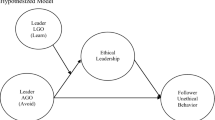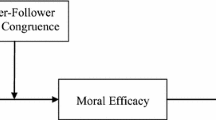Abstract
While previous research has established that employees who have a more conscientious leader are more likely to perceive that their leader is ethical, the underlying mechanisms and boundary conditions of this linkage remain unknown. In order to better understand the relationship between leader conscientiousness and ethical leadership, we examine the potential mediating role of leader moral reflectiveness, as well as the potential moderating role of decision-making autonomy. Drawing from social cognitive theory, results from two samples of workgroup leaders and their immediate reports situated in Africa and Asia show that leader conscientiousness is positively related to leader moral reflectiveness, which in turn, is positively associated with employees’ assessment of ethical leadership. Furthermore, and consistent with our hypothesis, results from the two samples show that leader decision-making autonomy moderates the indirect path from leader conscientiousness to ethical leadership through moral reflectiveness, such that only morally reflective leaders who have high (versus low) decision-making autonomy at work engage in ethical leadership behaviors. In our discussion, we highlight the theoretical and practical implications of our findings and suggest ways in which organizations can better foster ethical leadership.



Similar content being viewed by others
References
Babalola, M. T., Stouten, J., Euwema, M., & Ovadje, F. (2016). The relation between ethical leadership and workplace conflicts: The mediating role of employee resolution efficacy. Journal of Management. doi:10.1177/0149206316638163.
Babalola, M. T., Stouten, J., Camps, J., & Euwema, M. (2017). When do ethical leaders become less effective: The moderating role of perceived leader ethical conviction on employee discretionary reactions to ethical leadership. Journal of Business Ethics. doi:10.1007/s10551-017-3472-z.
Bandura, A. (1986). Social foundations of thought and action. Englewood Cliffs, NJ: Prentice Hall.
Bandura, A. (1991). Social cognitive theory of self-regulation. Organizational Behavior and Human Decision Processes, 50, 248–287.
Barrick, M. R., & Mount, M. K. (2005). Yes, personality matters: Moving on to more important matters. Human Performance, 18, 111–118.
Becker, T. E. (1998). Integrity in organizations: Beyond honesty and conscientiousness. Academy of Management Review, 23, 154–161.
Brislin, R. W. (1980). Translation and content analysis of oral and written material. Handbook of Cross-Cultural Psychology, 2(2), 349–444.
Brown, M. E., Treviño, L. K., & Harrison, D. (2005). Ethical leadership: A social learning perspective for construct development and testing. Organizational Behavior and Human Decision Processes, 97, 117–134.
Chen, C., Lee, S. Y., & Stevenson, H. W. (1995). Response style and cross-cultural comparisons of rating scales among East Asian and North American students. Psychological Science, 6, 170–175.
Chhokar, J. S., Brodbeck, F. C., & House, R. J. (2007). Culture and leadership across the world: The GLOBE book of in-depth studies of 25 societies. New York, NY: Taylor & Francis Group.
Collins, J. M., & Schmidt, F. L. (1993). Personality, integrity, and white collar crime: A construct validity study. Personnel Psychology, 46, 295–311.
Costa, P. T., & McCrae, R. R. (1992). Revised NEO Personality Inventory Professional Manual. Odessa, FL: Psychological Assessment Resources.
Den Hartog, D. N. (2015). Ethical leadership. Annual Review of Organizational Psychology and Organizational Behavior, 2, 409–434.
Donnellan, M. B., Oswald, F. L., Baird, B. M., & Lucas, R. E. (2006). The Mini-IPIP scales: Tiny-yet-effective measures of the Big Five factors of personality. Psychological Assessment, 18, 192–203.
Eisenbeiss, S. A., Van Knippenberg, D., & Boerner, S. (2008). Transformational leadership and team innovation: Integrating team climate principles. Journal of Applied Psychology, 93, 1438–1466.
Gino, F., & Mogilner, C. (2014). Time, money, and morality. Psychological Science, 25, 414–421.
Goldberg, L. R. (1999). A broad-bandwidth, public-domain, personality inventory measuring the lower-level facets of several five-factor models. Personality Psychology in Europe, 7, 7–28. doi:10.1016/j.jrp.2014.05.003.
Hackman, J. R., & Oldham, G. R. (1976). Motivation through the design of work: Test of a theory. Organizational Behavior and Human Decision Processes, 16, 250–279.
Haidt, J. (2001). The emotional dog and its rational tail: A social intuitionist approach to moral judgement. Psychological Review, 108, 814–834.
Hamamura, T., Heine, S. J., & Paulhus, D. L. (2008). Culture differences in response styles: The role of dialectical thinking. Personality and Individual Differences, 44, 932–942.
Hirst, G., Van Knippenberg, D., & Zhou, J. (2009). A cross-level perspective on employee creativity: Goal orientation, team learning behavior, and individual creativity. Academy of Management Journal, 52, 280–293.
Hofmann, D. A. (1997). An overview of the logic and rationale of hierarchical linear models. Journal of Management, 23(6), 723–744.
Hofmann, D. A., Morgeson, F. P., & Gerras, S. J. (2003). Climate as a moderator of the relationship between leader-member exchange and content specific citizenship: Safety climate as an exemplar. Journal of Applied Psychology, 88(1), 170–178.
Horn, J., Nelson, C. E., & Brannick, M. T. (2004). Integrity, conscientiousness, and honesty. Psychological Reports, 95, 27–38.
House, R. J., Hanges, P. J., Javidan, M., Dorfman, P. W., & Gupta, V. (Eds.). (2004). Culture, leadership, and organizations: The GLOBE study of 62 societies. Thousand Oaks, CA: Sage.
Judge, T. A., Bono, J. E., Illies, R., & Gerhardt, M. G. (2002). Personality and leadership: A qualitative and quantitative review. Journal of Applied Psychology, 87, 765–780.
Judge, T. A., Piccolo, R. F., & Kosalka, C. J. (2009). The bright and dark sides of leader traits: A review and theoretical extension of the leader trait paradigm. The Leadership Quarterly, 20, 855–875.
Kalshoven, K., Den Hartog, D. N., & De Hoogh, A. B. (2011). Ethical leader behavior and big five factors of personality. Journal of Business Ethics, 100, 349–366.
Karasek, R. (1979). Job demands, job decision latitude and mental strain: Implications for job redesign. Administrative Science Quarterly, 24, 285–308.
Kim, A., Kim, Y., Han, K., Jackson, S. E., & Ployhart, R. E. (2014). Multilevel influences on voluntary workplace green behavior: Individual differences, leader behavior, and coworker advocacy. Journal of Management. doi:10.1177/0149206314547386.
Kohlberg, L. (1981). The philosophy of moral development. San Francisco: Harper and Row.
Kreft, I. G. G. (1996). Are multilevel techniques necessary? An overview, including simulation studies. Working paper, California State University, Los Angeles, CA.
Landis, R. S., Beal, D. J., & Tesluk, P. E. (2000). A comparison of approaches to forming composite measures in structural equation models. Organizational Research Methods, 3, 186–207.
Mayer, D. M., Aquino, K., Greenbaum, R. L., & Kuenzi, M. (2012). Who displays ethical leadership, and why does it matter? An examination of antecedents and consequences of ethical leadership. Academy of Management Journal, 1, 151–171.
McCrae, R. R., & Costa, P. T., Jr. (1987). Validation of the five-factor model of personality across instruments and observers. Journal of Personality and Social Psychology, 52, 81–90.
Morgeson, F. P., & Humphrey, S. E. (2006). The Work Design Questionnaire (WDQ): Developing and validating a comprehensive measure for assessing job design and the nature of work. Journal of Applied Psychology, 91, 1321–1339.
Muthén, B., & Asparouhov, T. (2009). Multilevel regression mixture analysis. Journal of the Royal Statistical Society: Series A: Applied Statistics, 172, 639–657.
Newman, A., Kiazad, K., Miao, & Cooper, B. (2014). Examining the cognitive and affective trust-based mechanisms underlying the relationship between ethical leadership and organizational citizenship: A case of the head leading the heart? Journal of Business Ethics, 123, 113–123.
Ng, K., Ang, S., & Chan, K. (2008). Personality and leader effectiveness: A moderated mediation model of leadership self-efficacy, job demands, and job demands, and job autonomy. Journal of Applied Psychology, 93, 733–743.
Ogunfowora, B. (2014a). It’s all a matter of consensus: Leader role modeling strength as a moderator of the links between ethical leadership and employee outcomes. Human Relations, 67, 1467–1490.
Ogunfowora, B. (2014b). The impact of ethical leadership within the recruitment context: The roles of organizational reputation, applicant personality, and value congruence. The Leadership Quarterly, 25(3), 528–543.
Pelletier, K. L., & Bligh, M. C. (2008). The aftermath of organizational corruption: Employee attributions and emotional reactions. Journal of Business Ethics, 80(4), 823–844.
Podsakoff, P. M., MacKenzie, S. B., & Podsakoff, N. P. (2012). Source of method bias in social science research and recommendations on how to control it. Annual Review of Psychology, 63I, 539–569.
Preacher, K. J., Zyphur, M. J., & Zhang, Z. (2010). A general multilevel SEM framework for assessing multilevel mediation. Psychological Methods, 15, 209–233.
Reynolds, S. J. (2008). Moral attentiveness: Who pays attention to moral aspects of life? Journal of Applied Psychology, 93, 1027–1041.
Sturm, R. E. (2015). Decreasing unethical decisions: The role of morality-based individual differences. Journal of Business Ethics. doi:10.1007/s10551-015-2787-x.
Tett, R. P., & Burnett, D. D. (2003). A personality trait-based interactionist model of job performance. Journal of Applied Psychology, 88, 500–517.
Tucker, S., Ogunfowora, B., & Ehr, D. (2016). Safety in the c-suite: How chief executive officers influence organizational safety climate and employee injuries. Journal of Applied Psychology, 101(9), 1228–1239.
Walumbwa, F. O., & Schaubroeck, J. (2009). Leader personality traits and work group psychological safety. Journal of Applied Psychology, 94, 1275–1286.
Zhu, W., He, H., Treviño, L. K., Chao, M. M., & Wang, W. (2015). Ethical leadership and follower voice and performance: The role of follower identifications and entity morality beliefs. The Leadership Quarterly, 26, 702–718.
Zhu, W., Treviño, L. K., & Zheng, X. (2016). Ethical leaders and their followers: The transmission of moral identity and moral attentiveness. Business Ethics Quarterly, 26, 95–115.
Zyphur, M. J., & Oswald, F. L. (2015). Bayesian estimation and inference: A user’s guide. Journal of Management, 41, 390–420.
Author information
Authors and Affiliations
Corresponding author
Ethics declarations
Conflict of interest
The authors have no conflict of interest.
Informed Consent
Informed consent was obtained from all individual participants in the study.
Rights and permissions
About this article
Cite this article
Babalola, M.T., Bligh, M.C., Ogunfowora, B. et al. The Mind is Willing, but the Situation Constrains: Why and When Leader Conscientiousness Relates to Ethical Leadership. J Bus Ethics 155, 75–89 (2019). https://doi.org/10.1007/s10551-017-3524-4
Received:
Accepted:
Published:
Issue Date:
DOI: https://doi.org/10.1007/s10551-017-3524-4




